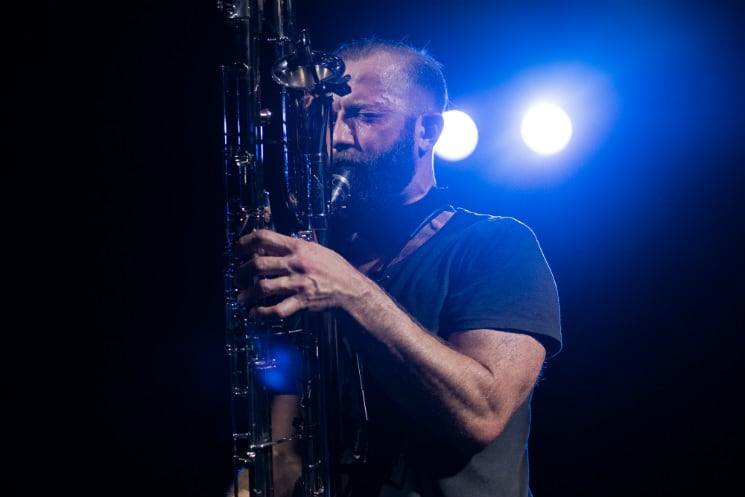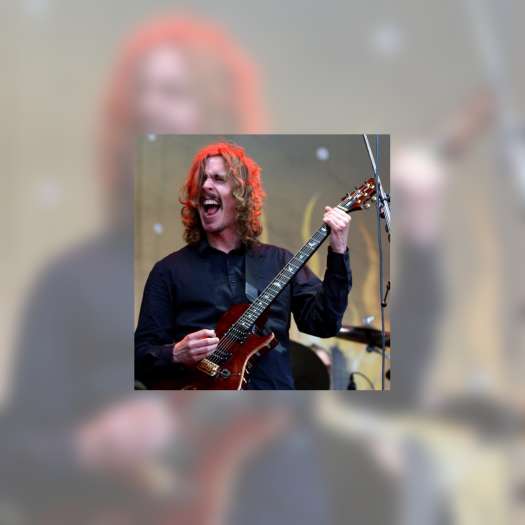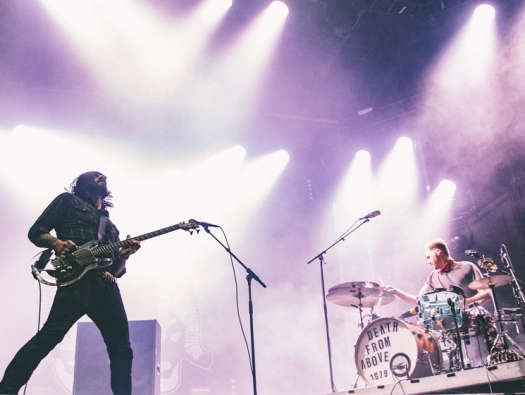Colin Stetson isn't a singer, but you could recognize his voice from anywhere. Passed through a dog collar microphone, his hoarse wail is as distinct as the low, loping drones that tear forth from his famous bass saxophone.
Concertgoers heard this plaintive call loud and clear last night (May 15), as his brassy bellows barrelled through Toronto's Great Hall. The 45-minute set hewed closely to selections from his recently released All This I Do For Glory LP, but it reinforced the appeal that has underlined Stetson's entire output. His playing demonstrated the masterful sense of control and endurance that have won him acclaim from avant-garde circles and pop audiences alike.
Opener "Spindrift" certified the power of Stetson's performance as his alto sax filled the spacious halls with fleet, fluttery arpeggios. Yet early favourite "Judges" showed the true breadth of Stetson's abilities. He seemed to chafe against the song's cyclical structure, digressing into extended passages before snapping back into place like a rubber band. Vocal melodies accompanied these returns, shortened and amplified into frustrated shrieks.
Throughout the night, Stetson established patterns like these before extending them right up to the edge of breaking, challenging and delighting the audience simultaneously. Picking up a contrabass clarinet for "Between Water and Wind," he decayed and distorted drones before wrenching them into an orderly, oscillating riff with a squeal similar to a car peeling out of a parking lot. Stetson didn't always reinvent the wheel, as "All This I Do For Glory" barely diverged from its recorded counterpart, yet even that rendition served as something of a relief, offering a woozy respite from the multiphonic grind of the previous song.
Alone onstage, Stetson possesses an almost Spartan resourcefulness. The saxophones' clattering keys served textural and rhythmic purposes; mimicking brittle snares and towering toms alike, they tapped out mammoth death marches and battle charges to match the pitch of his playing.
Critics have often noted the athleticism involved in Stetson's performances, from his demanding circular breathing technique to the long reach between his saxophone keys. Yet aside from his reddened face and the occasional stretch between songs, he showed little sign of wear. His instruments are too unwieldy to seem weightless, but he handled them with little trouble.
Physically imposing even without his gigantic saxophone, Stetson seemed to regulate his gestures as much as his breathing. Like his music, he always seemed to be in motion despite his rigid posture, even if he was just stepping gingerly in place. He would sway back and forth in time with the music before leaning into a half-lunge on heavier notes.
Yet for all his exertion and authority, Stetson seemed remarkably jovial. He thanked the crowd early and often, hinted at new material and joked with audience members. His ability to swing from uncompromising to accessible showed a range that few can match, and his sway over the audience demonstrated a command of more than just the saxophone.
Concertgoers heard this plaintive call loud and clear last night (May 15), as his brassy bellows barrelled through Toronto's Great Hall. The 45-minute set hewed closely to selections from his recently released All This I Do For Glory LP, but it reinforced the appeal that has underlined Stetson's entire output. His playing demonstrated the masterful sense of control and endurance that have won him acclaim from avant-garde circles and pop audiences alike.
Opener "Spindrift" certified the power of Stetson's performance as his alto sax filled the spacious halls with fleet, fluttery arpeggios. Yet early favourite "Judges" showed the true breadth of Stetson's abilities. He seemed to chafe against the song's cyclical structure, digressing into extended passages before snapping back into place like a rubber band. Vocal melodies accompanied these returns, shortened and amplified into frustrated shrieks.
Throughout the night, Stetson established patterns like these before extending them right up to the edge of breaking, challenging and delighting the audience simultaneously. Picking up a contrabass clarinet for "Between Water and Wind," he decayed and distorted drones before wrenching them into an orderly, oscillating riff with a squeal similar to a car peeling out of a parking lot. Stetson didn't always reinvent the wheel, as "All This I Do For Glory" barely diverged from its recorded counterpart, yet even that rendition served as something of a relief, offering a woozy respite from the multiphonic grind of the previous song.
Alone onstage, Stetson possesses an almost Spartan resourcefulness. The saxophones' clattering keys served textural and rhythmic purposes; mimicking brittle snares and towering toms alike, they tapped out mammoth death marches and battle charges to match the pitch of his playing.
Critics have often noted the athleticism involved in Stetson's performances, from his demanding circular breathing technique to the long reach between his saxophone keys. Yet aside from his reddened face and the occasional stretch between songs, he showed little sign of wear. His instruments are too unwieldy to seem weightless, but he handled them with little trouble.
Physically imposing even without his gigantic saxophone, Stetson seemed to regulate his gestures as much as his breathing. Like his music, he always seemed to be in motion despite his rigid posture, even if he was just stepping gingerly in place. He would sway back and forth in time with the music before leaning into a half-lunge on heavier notes.
Yet for all his exertion and authority, Stetson seemed remarkably jovial. He thanked the crowd early and often, hinted at new material and joked with audience members. His ability to swing from uncompromising to accessible showed a range that few can match, and his sway over the audience demonstrated a command of more than just the saxophone.




